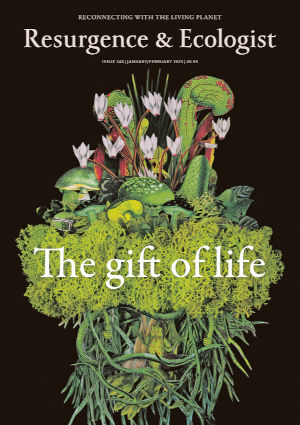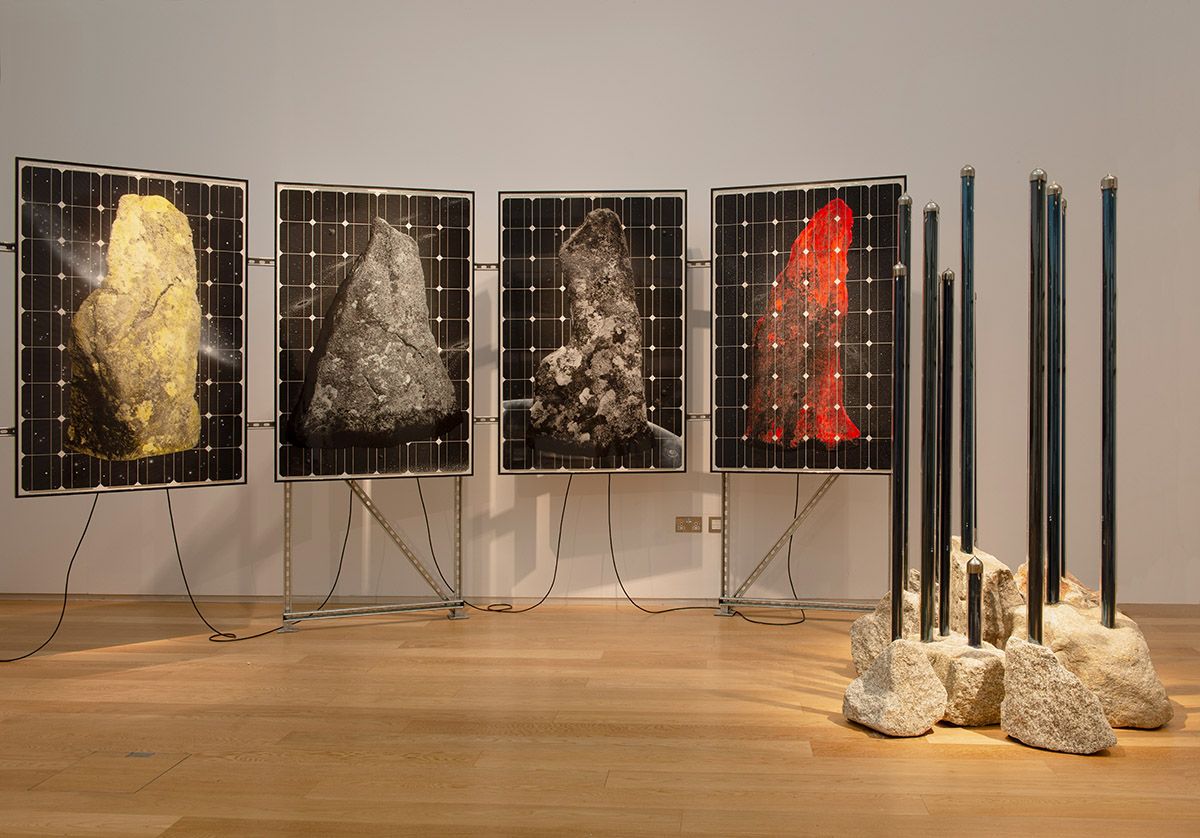Lara Goodband writes: “With its open spaces, ancient woodland and layered traces of human activity, Dartmoor has long attracted artists – often depicting the landscape as a picturesque rural idyll – so not surprisingly it is home to a thriving artistic community whose work is recognised internationally.
“Attracted by a particular ‘presence’ in the Dartmoor landscape, these artists have used photography to capture their personal and emotional connections to this special place. And with works spanning 55 years, this new exhibition invites us all to consider our relationship with the specific Dartmoor landscape, and the changes that have happened during that time, and to think what we would like to see and be able to experience in the future.
“The artists represented in the exhibition feel a strong emotional and spiritual connection to living, experimenting and creating on the moor. In the late 1960s, for example, Robert Smithson and Nancy Holt visited and made experimental work together at Wistman’s Wood, and more recently Dartmoor has become synonymous with the National Park’s legal battle to retain wild camping.
“What we see, in variety, form and approach, are links to the otherworldly and non-human, and my hope is that this exhibition’s attention to these urgent issues will bring a renewed re-focus to this ‘wild’ place – a landscape that both stimulates debate and continues to inspire creativity.”
Matthew Shaw reviews the exhibition and talks to some of the artists whose work is on show.
Dartmoor: A Radical Landscape is a celebration of the moorland, of the standing stones and natural rock formations, the streams and spaces where land and water meet, but also of the people who have lived and made their home on Dartmoor. Through their love of the moor people have fought for it, been inspired by it and celebrated it.
Dartmoor is an energetically charged place, a thin* place where it is possible to truly feel part of Nature, and a place full of potential, and this exhibition comes at a crucial moment in its history and conversations around access – or, more pertinently, lack of access. And what strikes me as I walk around this exhibition is how this location has been both a place of freedom for people and a place of creative immersion; a place to lose yourself in order to find yourself.
Anyone who has spent time on these moors will know how quickly the weather comes in, and, because of that, how quickly visibility can change. They will know too how Dartmoor’s vital natural beauty offers a place for deep reflection with poetic transformation, which can similarly transport you completely. If we lose the contested right to roam freely and wild camp, Dartmoor becomes something other: a rule-bound place, out of bounds, and as a result we may be robbed of these magical and radical possibilities.
A BOLD MOVE
On entering the gallery space, the first thing I see is ‘LIFEDEATH’ by Richard Long, a four-day walk from 2011 transformed into a poem. As I turn, I am met by a series of stunning images by Nancy Holt, again merging poetry and photography, but this time the poems were buried as part of the work. The presence of these two artists certainly sets the tone for this exhibition, and a very high bar for all of the work that follows – a bold move.
Alex Hartley’s new piece ‘The Summoning Stones’ captivated me. Alex tells me that he has lived on Dartmoor for over twenty years, and that he climbs, cycles and walks the moor daily. I was curious as to the intention of his new work. In a museum like RAMM I wandered around trying to find resonant objects, objects that appear to have that kind of magic that I look for in sculpture,” he explains.
“I’ve been making sculpture now for thirty-something years and I know how hard it is to invest an object with any sort of magic. That’s always the quest and nearly always it fails; this is the journey. But there are some objects in RAMM that really do have that. That’s the same thing I look for as I walk around Dartmoor.
“I walk around the standing stones or the stone rows, and some of them are dead to me and I get nothing, but sometimes I can really feel the energy and that connectivity to the past lives that have been through here.
“I thought for this work I would try and address this head-on. To invest the images of the rocks I make with real energy. To short-circuit this bit of vibrant matter, so it really is like the rocks are full of this energy and power that’s generated through the solar panels, which are looped together. And as you, the viewer, stand in the centre of this parabolic arc, that power is coming to you. An energy transfer between you and these objects.
“Alongside the panels I have drilled holes into granite boulders, and I’ve put solar thermal tubes into the stone. They are the tubes that you have on roofs that heat hot water, but they are also beautiful things. If you put them in the sun the ends become incredibly hot and if you plunge them into these rocks, Excalibur-like, as a way of the rock holding energy, not as a metaphor but a real transfer of energy and containment, there’s something about the question of how you can make an object that can hold that energy.”
FRIENDSHIP AND LANDSCAPE
In the next gallery I am immediately struck by the scale of some of the work on display and the stunning photographs by Susan Derges, who uses the Dartmoor landscape at night as both studio and darkroom, mingling moonlight and the movement of water and paper in a way that is alchemically harmonised into creating beautiful works.
Across the room is a much smaller glass cabinet. Here I lean in to explore the work of artist Laura Hopes and academic Katharine Earnshaw, who also made Dartmoor their studio, as a place for thinking, discussing and the making of a collaborative ‘collaged book’, a work that deals with the ethics of friendship and how this might help our thinking about the environmental crisis and our relationship with the land.
I speak with Laura about their process and this work that she and Katharine have made together: “Katharine is an incredible resource, so familiar with the ancient texts, and it’s always astonishing how relevant they are to understanding place.
“As an artist you’re always, in a slightly ‘magpie-ish’ way, interested in things that other people haven’t found. Together we found a way of collapsing together what we do to work together collaboratively.
“Artistry and friendship have blended together into an active way of meaning and making. This is really pertinent to Dartmoor because it’s not just a deeply interesting place but also a working environment where people have lived with animals and visiting tourists; it has so many layers. You can’t really prioritise one singular voice over others.
“Katharine and I have developed the idea of establishing friendship with landscape, which became more obtainable and realistic and a useful model to take forward to try and communicate landscape history and think about who gets to access land and who gets to use it now. We used something called a commonplace book, quite often collaged together with texts and images, which is a sort of guidebook or scrapbook – memories of a place.”
The pages from these commonplace books that are shared in the exhibition show moments of the two friends’ research, fragments of a wider project. Love letters to landscape friendship. And Katharine explains more to me about the texts she brought to the project: “I work on what are called ancient didactic texts that teach us things. Some of what they teach you is how to farm from agricultural texts, but a lot of them are linked more to what the make-up of the universe is. Some are cosmological texts, so quite different sorts of content, but what they all have in common is that they are all ethical texts one way or another.”
WINDSWEPT DARTMOOR
I pause to look at ‘Breathing in the Beech Wood, Homeland, Dartmoor, Twenty-Four Days of Sunlight’ by Garry Fabian Miller. This piece contains 81 beech leaves developed directly onto photosensitive paper without the use of a camera; 24 days of changing colour, the fallen leaves from a windswept Dartmoor captured for all to see.
Behind this piece there is a film playing alongside magic lantern slides of Dartmoor from the RAMM collection. The film is titled Cinematics of Gaia and Magic and is by the artist Ashish Ghadiali. It is inspired by a conversation with the Gaia theorist James Lovelock in the final year of his life and features Ashish’s daughter asking questions of an AI bot. As I sit and watch the flowing water of the film with the repeated phrase ‘Can you tell the time of a running river?’ I am moved by the intergenerational aspect of this exhibit and heartened by the continuation of work that Lovelock began and people like the late Stephan Harding continued.
The final series of powerful photographs feature the Right to Roam movement and are by photographer Fern Leigh Albert. These images bring me back to the present tense and the need for protest and campaigning to protect our rights of access to the land.
This is an exhibition I look forward to returning to as much as I love to return to walk on Dartmoor itself.
*A ‘thin place’ is a term used to describe a location where the boundary between the physical and spiritual worlds is said to be ‘thin’ or especially permeable.
Dartmoor: A Radical Landscape is at RAMM, Exeter, until 23 February 2025. www.rammuseum.org.uk/whats-on/dartmoor-a-radical-landscape








